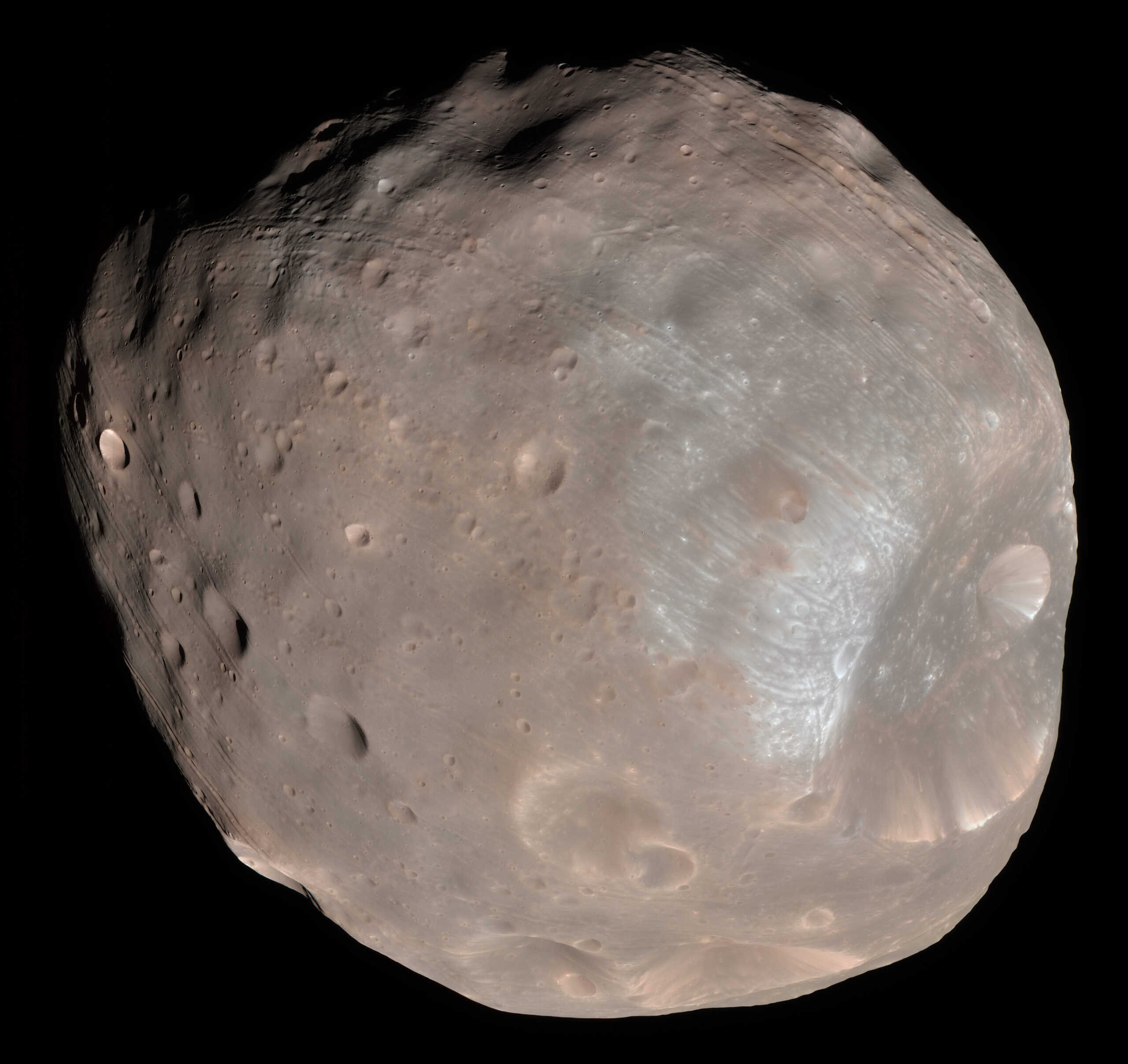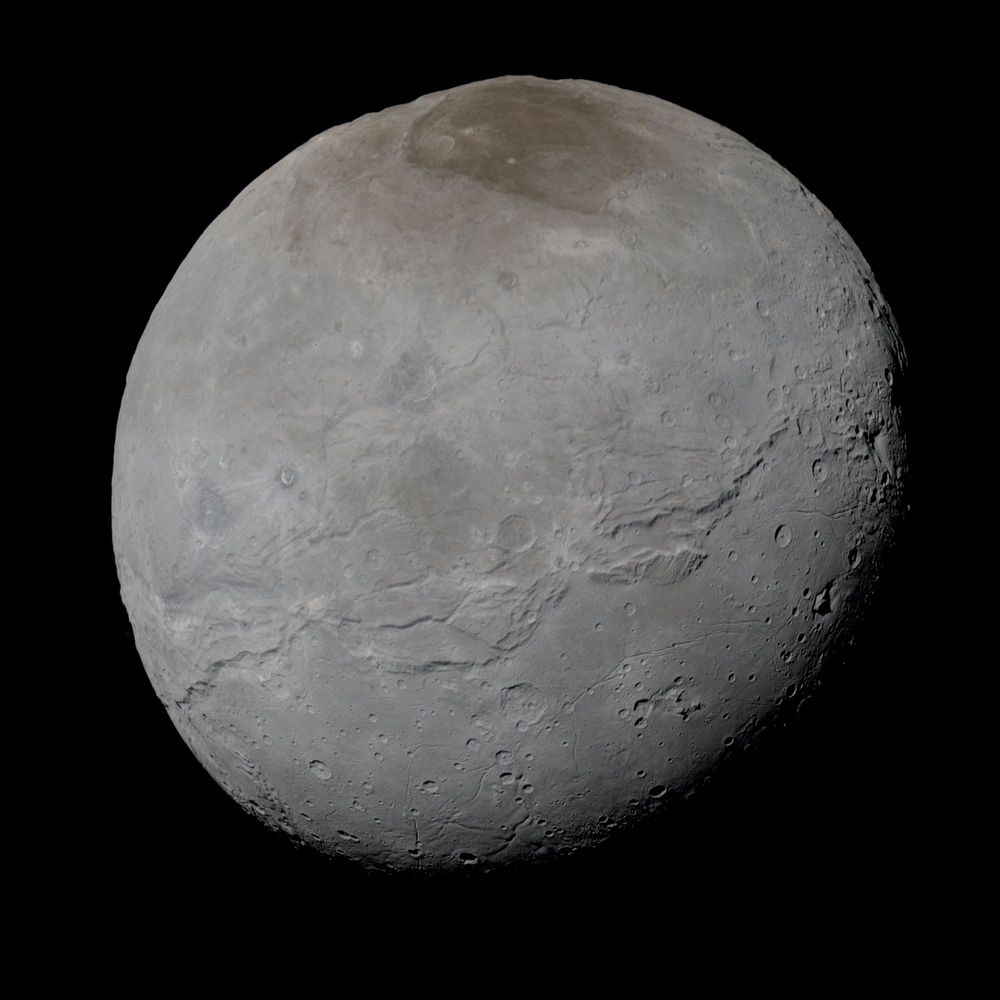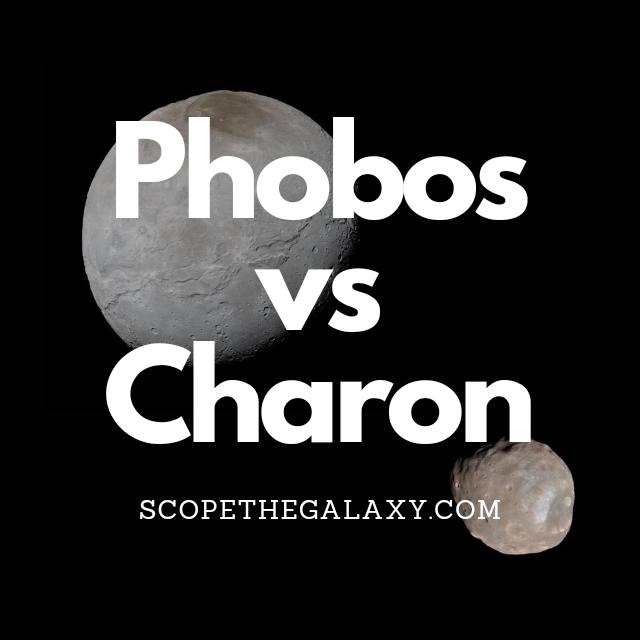*This post may contain affiliate links. This means we may make a commission if you purchase an item using one of our links*
The main differences between Phobos and Charon are that Phobos orbits Mars while Charon orbits Pluto, Phobos is far smaller with a diameter of 22.53km while Charon’s is 1,212km and Charon has a more spherical shape to its body unlike Phobos which is more oval.
There are various other differences between these two, so continue reading for a more in-depth look at both moons along with their similarities and differences below.
What Is The Moon Phobos?
Table of Contents

Phobos is the larger and innermost of the Martian moons, named after the Greek God of fear and panic. This rocky satellite measures approximately 27 x 22 x 18 kilometers and possesses an irregular shape.
Flying only 270 km above Mars’s surface, Phobos orbits the Martian surface so closely that it spins around the planet three times a day (each orbit takes 7 hours and 39 minutes). And this proximity means that the moon cannot always be seen from Mars’ surface (it all depends on where you’re standing).
In general, Phobos rises in the west, passes through the sky in around 4 hours, and sets in the east. And this process occurs twice during one Martian day.
Phobos travels 1.8 m closer to Mars every 100 years, which means this doomed moon will one day crash into its planet or break up into rings. Still, this won’t happen for another 50 million years or so.
The moon is covered in streak patterns from impact craters, the most significant of which is the crater Stickney, with a diameter of 9.7 km. Phobos has weathered thousands of meteorite impacts, one of which almost shattered it to pieces.
It was first discovered by the American astronomer Asaph Hall on 17th August 1877. But, it can be difficult for astronomers to see as it is one of the least reflective bodies in the solar system with an albedo of 0.071.
Despite its small stature, Phobos experiences wildly varying temperatures on its dark side compared to the light side. Measurements on the light side of the moon suggest that temperatures can rise to -4 degrees Celsius, a sort of brisk winter’s day that would be cold but tolerable.
In contrast, temperatures on the dark side can drop to -112 degrees Celsius, even though the two areas are just a few kilometers apart. The probable cause is fine surface dust that cannot retain heat, allowing temperatures to drop rapidly.
The low density of Phobos suggests its composition is similar to carbonaceous chondrite meteorites, which could mean that Phobos is a captured asteroid.
What Is The Moon Charon?

Charon is the largest of Pluto’s moons, first discovered on 22nd June 1978. The surface of this icy world is frozen with nitrogen and methane ice; it may also hold some water ice. While Pluto possesses a reddish hue, Charon is closer to a neutral shade of grey; this suggests the two bodies have different compositions.
Scientists named this moon after the mythical ferryman, Charon, who once carried souls across the Acheron river. This river is one of five legendary rivers that could lie beneath the surface of Pluto.
The formation of Charon remains something of a mystery to scientists. However, this moon may have formed around 4.5 billion years ago when an object traveling at immense speed collided with Pluto. Its average distance from the Sun is approximately 3.6 billion km.
Charon is almost half the size of its planet at 1,212km, where scientists refer to these two bodies as a “double dwarf planet system,” and the chilly temperatures vary from minus 23 to minus 258 degrees Celsius.
Charon takes 153 hours to orbit its planet at an average distance of 19,640km, and it is tidally locked, meaning the same side of the moon always faces Pluto. Pluto also experiences a tidal lock to Charon, so the same two sides always face one another.
Among the fascinating features of this ice moon are the ice volcanoes that could exist on the surface. Observations from the Gemini observatory suggest that Charon could have a form of cryovolcanism known as ice-particle geysers.
The frigid world also has a canyon between seven and nine kilometers deep. (To put that into perspective, Mount Everest has a height of 8.8km).
Similarities Between Phobos And Charon
As both are natural satellites, Charon and Phobos do share a few similarities, which includes the following:
- Both have a rocky, terrestrial surface.
- Neither have rings surrounding them.
- Both are tidally locked to their planet.
- Both orbit their planet in an elliptical pattern.
- Neither have a magnetic field.
- Neither have tectonic plates
- Both entities have practically no atmosphere
Differences Between Phobos And Charon
As for the differences between the two, they include the below:
- Phobos orbits Mars whilst the Charon orbits Pluto.
- Charon is a spherical shape while Phobos is not.
- Charon has a diameter of 1,212km whilst Phobos has a diameter of 22.53km.
- A day on Phobos takes 7 hours 39 minutes whilst a Charon day is 153 hours.
- It takes Phobos 7 hours 39 minutes to orbit Mars and around the Sun in 687 days whilst Charon orbits Pluto in in 153 hpurs and the Sun in 247.78 years.
- Phobos’ temperature ranges between -4 to -112 degrees Celsius whilst Charon’s is around -23 to -258 degrees Celsius.
- Charon orbits Pluto at an average distance of 19,640km whilst Phobos is 6,000km away from Mars.
- Charon’s density is 1.71 g/cm³ whilst Phobo’s density is 1.88 g/cm³.
- Charon’s mass is 1.58 × 10^21 kg whilst Phobos’ mass is 10.6 × 10^15 kg.
- Phobos’ gravitational strength is 0.0057 m/s² whilst Charon’s is 0.288 m/s² .
- Phobos only orbits Mars 6,000km away and is getting closer to the planet by 1.8 meters every 100 years.
Summary
Both Phobos and Charon are natural satellites, are tidally locked to their respective planets and are rock based however, they are still unique when you breakdown their features
Whether it be in regards to their mass, size, physical shape, gravitational strength, how they orbit their respective planets and more, Charon and Phobos are still very distinct celestial bodies in their own right.

